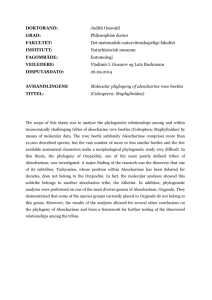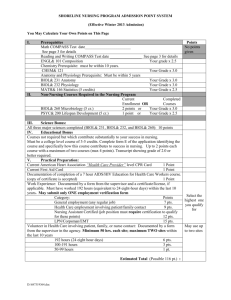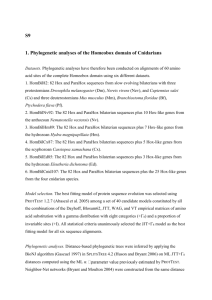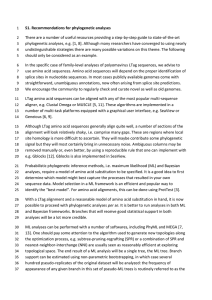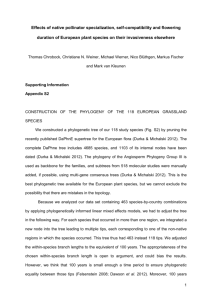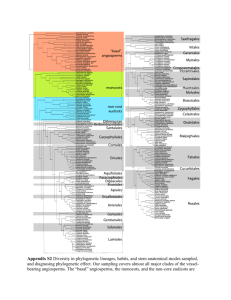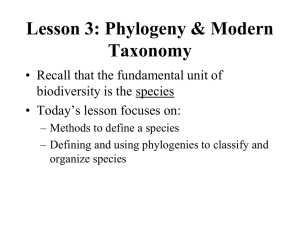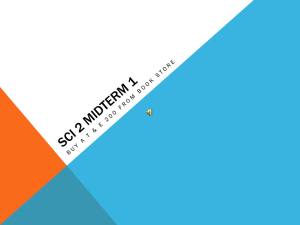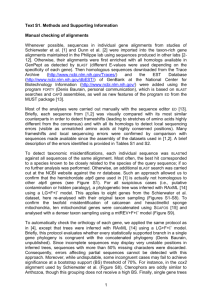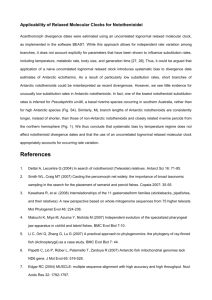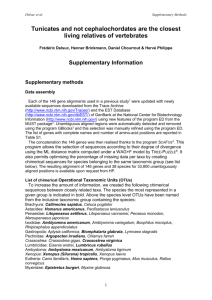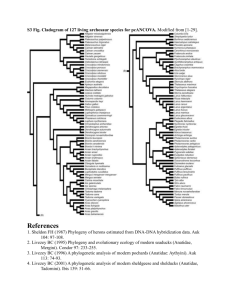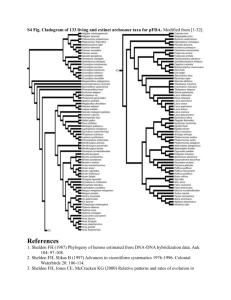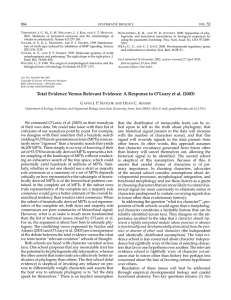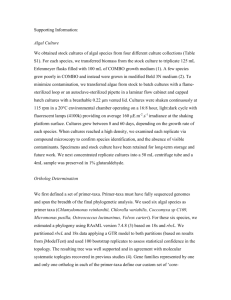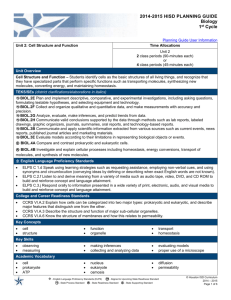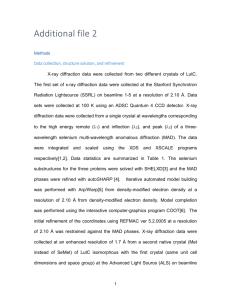Additional file 1 –Methods for phylogenetic reconstruction and in
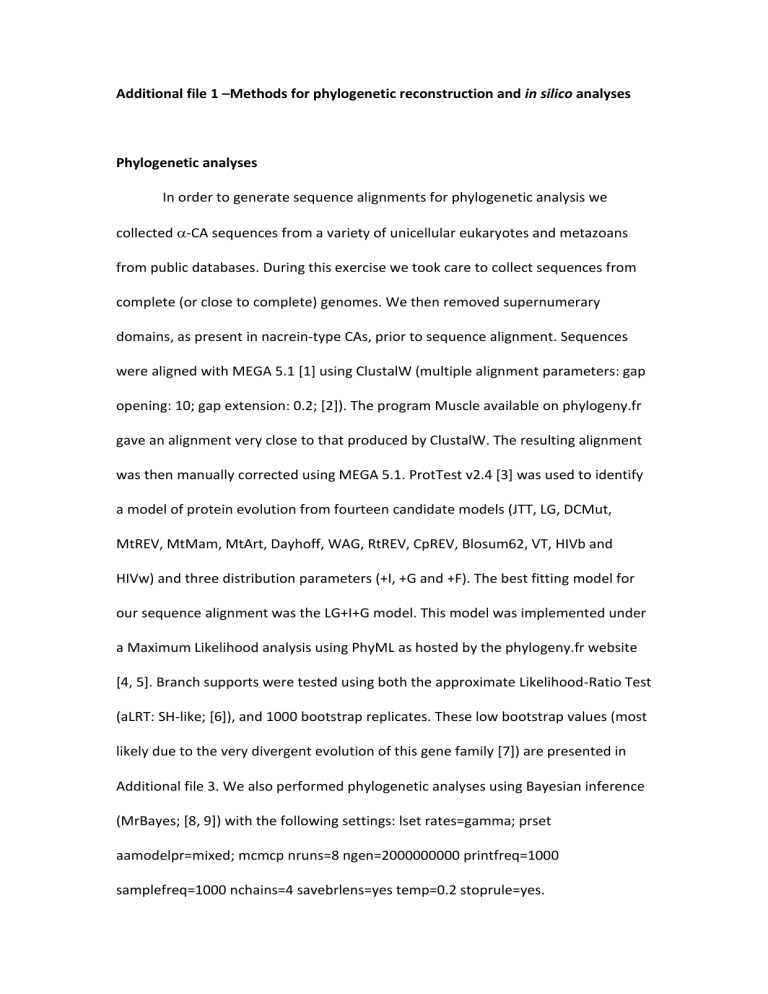
Additional file 1 –Methods for phylogenetic reconstruction and in silico analyses
Phylogenetic analyses
In order to generate sequence alignments for phylogenetic analysis we collected -CA sequences from a variety of unicellular eukaryotes and metazoans from public databases. During this exercise we took care to collect sequences from complete (or close to complete) genomes. We then removed supernumerary domains, as present in nacrein-type CAs, prior to sequence alignment. Sequences were aligned with MEGA 5.1 [1] using ClustalW (multiple alignment parameters: gap opening: 10; gap extension: 0.2; [2]). The program Muscle available on phylogeny.fr gave an alignment very close to that produced by ClustalW. The resulting alignment was then manually corrected using MEGA 5.1. ProtTest v2.4 [3] was used to identify a model of protein evolution from fourteen candidate models (JTT, LG, DCMut,
MtREV, MtMam, MtArt, Dayhoff, WAG, RtREV, CpREV, Blosum62, VT, HIVb and
HIVw) and three distribution parameters (+I, +G and +F). The best fitting model for our sequence alignment was the LG+I+G model. This model was implemented under a Maximum Likelihood analysis using PhyML as hosted by the phylogeny.fr website
[4, 5]. Branch supports were tested using both the approximate Likelihood-Ratio Test
(aLRT: SH-like; [6]), and 1000 bootstrap replicates. These low bootstrap values (most likely due to the very divergent evolution of this gene family [7]) are presented in
Additional file 3. We also performed phylogenetic analyses using Bayesian inference
(MrBayes; [8, 9]) with the following settings: lset rates=gamma; prset aamodelpr=mixed; mcmcp nruns=8 ngen=2000000000 printfreq=1000 samplefreq=1000 nchains=4 savebrlens=yes temp=0.2 stoprule=yes.
In silico analyses
The in silico characterization of selected -CA sequences, including their putative localization, was performed using several tools: ProtParam
(http://web.expasy.org/protparam/: [10]), TMpred
(http://www.ch.embnet.org/software/TMPRED; [11]), SignalP
(http://www.cbs.dtu.dk/sevices/SignalP; [12]), SOSUI (http://www.bp.nuap.nagoyau.ac.jp/sosui; [13]) and TargetP 1.1 (http://www.cbs.dtu.dk/services/TargetP/; [14]).
In addition we analysed these sequences with the SMART software
(http://smart.embl-heidelberg.de; [15]) to identify the presence of peculiar modular domains. The biochemical properties of these domains were then individually analysed with ProtParam.
1. Tamura K, Peterson D, Peterson N, Stecher G, Nei M, Kumar S: MEGA5:
Molecular Evolutionary Genetics Analysis using Maximum Likelihood,
2.
3.
Evolutionary Distance, and Maximum Parsimony Methods. Mol Biol Evol
2011, 28:2731-2739.
Thompson JD, Higgins DG, Gibson TJ: CLUSTAL W: improving the sensitivity of progressive multiple sequence alignment through sequence weighting,
positions-specific gap penalties and weight matrix choice. Nucleic Acids Res
1994, 22:4673-4680.
Abascal F, Zardoya R, Posada D: ProtTest: Selection of best-fit models of
protein evolution. Bioinformatics 2005, 21:2104-2105.
4.
5.
6.
7.
Méthodes et Algorithmes pour la Bioinformatique LIRMM
[www.phylogeny.fr]
Guindon S, Gascuel O: A simple, fast, and accurate algorithm to estimate
large phylogenies by maximum likelihood. Syst Biol 2003, 52:696-704.
Anisimova M, Gascuel O: Approximate likelihood‐ratio test for branches: a
fast, accurate, and powerful alternative. Syst Biol 2006, 55:539‐552.
Guindon S, Dufayard J-F, Lefort V, Anisimova M, Hordijk W, Gascuel O: New
8. algorithms and methods to estimate maximum-likelihood phylogenies:
assessing the performance of PhyML 3.0. Syst Biol 2010, 59:307-321.
Huelsenbeck JP, Ronquist F: MRBAYES: Bayesian inference of phylogeny.
Bioinformatics 2001, 17:754-755.
9. Ronquist F, Huelsenbeck JP: MRBAYES 3: Bayesian phylogenetic inference
under mixed models. Bioinformatics 2003, 19:1572-1574.
10. Gasteiger E, Hoogland C, Gattiker A, Duvaud S, Wilkins MR, Appel RD, Bairoch
A: Protein Identification and Analysis Tools on the ExPASy Server. In The
Proteomics Protocols Handbook. Edited by Walker J. New York: Humana
Press; 2005: 571-607
11. Hofmann K, Stoffel W: A database of membrane spanning proteins
segments. Biol Chem 1993, 374:166.
12. Bendtsen J, Nielsen H, von Heijne G, Brunak S: Improved prediction of signal
peptides: SignalP 3.0. J Mol Biol 2004, 340:783-795.
13. Hirokawa T, Boon‐Chieng S, Mitaku S: SOSUI: Classification and secondary
structure prediction system for membrane proteins. Bioinformatics 1998,
14:378‐379.
14. Emanuelsson O, Nielsen H, Brunak S, von Heijne G: Predicting subcellular
localization of proteins based on their N-terminal amino acid sequence. J
Mol Biol 2000, 300:1005-1016.
15. Schultz J, Milpetz F, Bork P, Ponting CP: SMART, a simple modular
architecture research tool: Identification of signaling domains. Proc Natl
Acad Sci USA 1998, 95:5857-5864.

